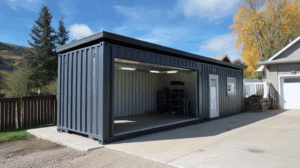Maximizing Space and Creativity: How a Shipping Container Can Serve as the Ultimate Garage Solution
Are you tired of parking your car on the street because your garage is overflowing with clutter? Do you dream of having a dedicated space where you can pursue your hobbies or work on DIY projects without any distractions? If so, then it’s time to consider the ultimate garage solution – a shipping container.
Thinking Outside the Box
Shipping containers have become increasingly popular in recent years, not just for transporting goods across the globe but also for repurposing into innovative structures. These sturdy, weather-resistant metal boxes are built to withstand the harshest of conditions, making them a perfect choice for creating a functional and versatile garage space.
Space Maximization
One of the biggest advantages of using a shipping container as a garage is the ability to maximize space. These containers come in various sizes, from 20 to 40 feet in length, providing ample room to accommodate your vehicle as well as other storage needs. With their rectangular shape, you can easily park your car inside while still having space for shelves, workbenches, and storage cabinets.
Customization and Flexibility
Shipping containers offer endless possibilities for customization and flexibility. Whether you want to create a simple garage or a fully equipped workshop, you can easily transform a shipping container to suit your specific needs. The steel walls can be modified to add windows, doors, skylights, or even extra ventilation for better airflow. You can also insulate the container to make it comfortable in any weather condition.
Organization and Clutter-Free Environment
If you’ve ever stepped inside a regular garage, you know how quickly it can become a cluttered mess. With a shipping container garage, you have the opportunity to start fresh and create an organized and clutter-free environment. Utilize wall-mounted storage solutions, overhead racks, and labeled containers to keep all your tools, equipment, and supplies neatly arranged and easily accessible. This will not only make your workspace more efficient but also reduce the time spent searching for items.
Creative Uses Beyond a Garage
While a shipping container makes an excellent garage solution, its uses don’t stop there. Think outside the box and explore the creative potential of repurposing a shipping container. You can transform it into a home gym, an art studio, a home office, or even a guesthouse. The possibilities are only limited by your imagination.
Cost-Effective and Eco-Friendly
Building a traditional garage can be a costly and time-consuming endeavor. In contrast, repurposing a shipping container is a much more cost-effective option. The containers are readily available, and their sturdy construction eliminates the need for extensive foundation work. Additionally, repurposing a shipping container is an eco-friendly choice, as it reduces waste and provides a sustainable alternative.
Conclusion
If you’re looking to maximize space, unleash your creativity, and create the ultimate garage solution, consider repurposing a shipping container. With their durability, customization options, and endless possibilities, shipping container garages are revolutionizing the way we think about storage and workspace solutions. Start thinking outside the box and unlock the potential of a shipping container as your ultimate garage solution.
Unconventional Garage Solutions: Exploring the Possibilities of Using a Shipping Container
When it comes to finding innovative and unique solutions for creating extra space, shipping containers have become an increasingly popular choice. Originally designed to transport goods across the globe, these robust and versatile structures have found new life as unconventional garage solutions. With their durable construction, portability, and customizable features, shipping containers offer a range of possibilities for those looking to expand their garage space in a creative way.
Durability and Strength
One of the key advantages of using a shipping container as a garage is its exceptional durability and strength. Built to withstand harsh weather conditions and rough handling during transportation, these containers are constructed with weather-resistant steel, making them highly resistant to corrosion and wear. This means that your belongings, whether it’s your beloved classic car or valuable tools, will be protected from the elements and potential theft.
Portability and Versatility
Another attractive feature of shipping containers is their portability. Unlike traditional garage constructions, these containers can be easily transported and relocated if needed. This flexibility allows you to adapt your garage space to suit your changing needs. Whether you’re moving to a new location or simply want to reposition your garage on your property, shipping containers offer the convenience and ease of relocation that traditional garages cannot match.
Customization Options
One of the most exciting aspects of using a shipping container as a garage is the wide range of customization options available. These containers can be transformed into functional and stylish garages that perfectly fit your needs and aesthetic preferences. From adding windows and doors to installing insulation and electrical systems, there are countless possibilities for customizing your shipping container garage.
Additionally, shipping containers come in various sizes, ranging from 10 feet to 40 feet in length, allowing you to choose the perfect size for your garage requirements. Whether you need a compact space for a single car or a larger area for multiple vehicles and storage, there is a shipping container size that will suit your needs.
Cost-Effective Solution
Compared to traditional garage constructions, using a shipping container as a garage can be a cost-effective alternative. The initial purchase price of a container is often significantly lower than the cost of building a conventional garage from scratch. Additionally, shipping containers require less maintenance and repair over time, saving you money in the long run.
Eco-Friendly Option
In an era where sustainability is a growing concern, repurposing shipping containers as garages is an eco-friendly choice. By giving these containers a new life instead of letting them end up in landfills, you are contributing to the reduction of waste and minimizing the environmental impact of construction materials.
Moreover, the steel used in shipping containers is highly recyclable, which means that even if you decide to replace or upgrade your garage in the future, the materials can be repurposed and reused, further reducing your carbon footprint.
Conclusion
If you’re looking for an unconventional and innovative solution to expand your garage space, consider the possibilities offered by shipping containers. With their durability, portability, customization options, cost-effectiveness, and eco-friendliness, these containers provide a unique and practical alternative to traditional garages. Whether you need extra storage, a workshop, or a shelter for your vehicles, a shipping container garage can be a stylish and functional addition to your property. Embrace the versatility and embrace the possibilities of using a shipping container for your garage needs.
Revolutionize Your Storage Space: A Guide to Converting a Shipping Container into a Functional Garage
Are you tired of constantly searching for tools, equipment, and other items scattered around your property? Do you dream of having a spacious and well-organized garage where you can store all your belongings? Look no further than a shipping container! These versatile and durable steel structures can easily be transformed into functional garages, providing you with ample storage space and peace of mind. In this guide, we will take you through the steps to revolutionize your storage space by converting a shipping container into a functional garage.
Step 1: Choosing the Right Shipping Container
The first step in this transformation process is selecting the right shipping container for your needs. Shipping containers come in various sizes, typically ranging from 10 to 40 feet in length. Consider the amount and size of items you plan on storing in your garage to determine the appropriate container size. Additionally, inspect the condition of the container to ensure it is structurally sound and free from any significant damage or corrosion.
Step 2: Preparing the Site
Before you bring in the shipping container, you must prepare the site where it will be placed. Clear any debris or vegetation, level the ground, and make sure the area is accessible for delivery. It’s essential to have a solid foundation, such as a concrete slab or gravel pad, to ensure the container remains stable and level.
Step 3: Insulating and Ventilating
Shipping containers are designed for transportation and storage of goods, not for human habitation. Therefore, insulation and ventilation are crucial in converting a container into a functional garage. Insulating the walls, ceiling, and floor will help regulate temperature and prevent condensation. Use high-quality insulation materials such as spray foam or rigid foam panels, and consider adding a vapor barrier to prevent moisture buildup.
Proper ventilation is equally important to prevent the buildup of stale air and odors. Install vents or fans to ensure adequate airflow and consider adding windows or skylights to bring in natural light.
Step 4: Electrical and Lighting
A functional garage requires proper electrical wiring and lighting. Consult with a licensed electrician to determine the electrical requirements for your garage and ensure all work is done safely and up to code. Install outlets, switches, and lighting fixtures strategically to accommodate your needs. Consider task lighting for specific work areas and motion-sensor lights for added convenience and security.
Step 5: Security and Access
Protecting your valuable belongings is paramount, so don’t overlook security measures when converting your shipping container into a garage. Reinforce the doors and windows with heavy-duty locks or security bars. You may also consider installing a security system or surveillance cameras to deter potential intruders.
Think about convenient access to your garage as well. If the container’s original doors are not sufficient, consider adding roll-up doors or a pedestrian door for easy entry and exit.
Step 6: Organizing and Customizing the Interior
Now that the structural and functional aspects of your shipping container garage are in place, it’s time to focus on organization and customization. Install shelves, cabinets, and racks to optimize storage space and keep everything tidy. Consider adding a workbench or a pegboard for tools and equipment. Use hooks, hangers, and magnetic strips to maximize vertical storage.
Furthermore, you can personalize the interior by painting the walls, adding flooring, or decorating with your preferred style. Make your garage an inviting and inspiring space that reflects your personality.
Step 7: Maintenance and Upkeep
Regular maintenance is vital to ensure the longevity and functionality of your shipping container garage. Inspect the container periodically for any signs of wear, damage, or leaks. Address any issues promptly to prevent further deterioration. Keep the interior clean and organized to make the most of your storage space.
Conclusion
Converting a shipping container into a functional garage offers a multitude of benefits, including increased storage space, improved organization, and enhanced security. By following these steps, you can transform a simple steel structure into a versatile and efficient garage that meets all your storage needs. So, revolutionize your storage space today and enjoy the convenience and peace of mind that a shipping container garage brings!
Thinking Outside the Box: Transforming a Shipping Container into Your Dream Garage
Are you tired of parking your car in a cluttered garage or on the street? Do you dream of having a spacious and organized space to work on your vehicles? Look no further! In this blog post, we will explore the innovative idea of transforming a shipping container into your dream garage.
The Advantages of a Shipping Container Garage
Cost-effective Solution
One of the biggest advantages of using a shipping container as a garage is its cost-effectiveness. Shipping containers are readily available and can be purchased at a fraction of the cost of building a traditional garage from scratch. This makes it an ideal option for those on a tight budget or looking to save money for other projects.
Durability and Security
Shipping containers are designed to withstand harsh conditions at sea, making them incredibly durable. They are made from high-quality steel that is resistant to rust, corrosion, and even fire. This ensures that your vehicles and tools will be protected from the elements and potential theft.
Modular and Versatile Design
Shipping containers come in various sizes, with the most common being 20 or 40 feet in length. Their modular design makes them easy to stack, arrange, and modify to suit your specific needs. Whether you require additional space for storage, a workshop area, or even an office space, a shipping container can be easily customized to meet your requirements.
Mobility and Flexibility
One of the unique advantages of a shipping container garage is its mobility. If you ever decide to move or relocate, you can simply transport your garage with you. This flexibility allows you to maintain your dream garage no matter where life takes you, whether it’s across town or across the country.
Transforming Your Shipping Container into Your Dream Garage
Now that we have explored the advantages of a shipping container garage, let’s dive into the exciting process of transforming it into your dream space.
Planning and Design
The first step in creating your dream garage is careful planning and design. Consider the size of the shipping container and how it will fit within your property. Determine the layout and functionality you desire, such as space for multiple vehicles, a workshop area, or storage shelves. Sketch out your ideas and consult with professionals if needed to ensure that your vision becomes a reality.
Insulation and Ventilation
Shipping containers are not naturally insulated, so it’s important to add insulation to maintain comfortable temperatures inside your garage. There are various insulation options available, such as spray foam, fiberglass batts, or rigid foam boards. Additionally, proper ventilation is crucial to prevent condensation and maintain air quality. Install vents or windows strategically to ensure proper airflow.
Electrical and Plumbing
Consider your electrical and plumbing needs when transforming your shipping container into a garage. If you plan to use power tools or have lighting fixtures, consult an electrician to install the necessary wiring. Similarly, if you require access to water for cleaning or maintenance purposes, consult a plumber to ensure proper plumbing installation.
Flooring and Interior Finishes
Select a suitable flooring material that can withstand the weight of your vehicles and any potential spills or leaks. Epoxy flooring or rubber tiles are popular options for a garage setup. Additionally, consider adding interior finishes such as drywall or plywood to create a polished and finished look.
Security and Organization
To ensure the safety and security of your vehicles and tools, invest in proper security measures. This may include installing sturdy locks, an alarm system, or security cameras. Organize your garage with shelving units, tool chests, and pegboards to keep everything in order and easily accessible.
Conclusion
Thinking outside the box and transforming a shipping container into your dream garage is an innovative and cost-effective solution. With its durability, versatility, and mobility, a shipping container garage offers endless possibilities. By carefully planning and designing your space, considering insulation, electrical, and plumbing needs, and incorporating proper security and organization, you can create a functional and stylish garage that will exceed your expectations. So why settle for a traditional garage when you can think outside the box and create a unique space that reflects your individuality and passion for cars?
From Cargo to Car Haven: The Pros and Cons of Using a Shipping Container as a Garage
When it comes to finding alternative solutions for storage and workspace needs, shipping containers have gained immense popularity over the years. Originally designed for transporting goods across long distances, these sturdy metal structures have found new life as homes, offices, and even garages. In this article, we’ll explore the pros and cons of using a shipping container as a garage, helping you make an informed decision for your storage needs.
The Pros:
1. Affordability
One of the primary advantages of using a shipping container as a garage is its affordability. Compared to traditional construction methods, purchasing and modifying a shipping container can be a cost-effective option. These containers are readily available in various sizes, and their price can depend on factors such as condition, age, and modifications required. With a little creativity and customization, you can transform an ordinary shipping container into a practical garage space for your vehicles.
2. Mobility
Shipping containers are designed to be easily transported, making them an excellent choice for those who may need to relocate their garage in the future. Whether you’re moving to a new property or want the flexibility to change the layout of your space, a shipping container can be easily transported using a flatbed truck or crane. This mobility can be especially beneficial for businesses or individuals who require temporary storage solutions or workspaces.
3. Durability and Security
Shipping containers are built to withstand the harshest of conditions, making them incredibly durable and secure. Constructed with weather-resistant steel, these containers can withstand extreme temperatures, heavy winds, and even earthquakes. Additionally, their robust design provides excellent protection against theft and vandalism, giving you peace of mind knowing your vehicles and belongings are safe.
4. Customization Options
Shipping containers offer a blank canvas for customization, allowing you to tailor the space to your specific needs. From adding windows and doors to insulation and electrical wiring, you can transform a shipping container into a fully functional garage equipped with lighting, power outlets, and any other amenities you require. Moreover, containers can be stacked or arranged in various configurations to create larger garage spaces or accommodate multiple vehicles.
The Cons:
1. Limited Space
While shipping containers come in different sizes, they still have limitations in terms of space. Most standard containers have a width of around 8 feet and a length of 20 or 40 feet, which may not be suitable for larger vehicles or those who require additional storage space. However, it is possible to modify containers by joining multiple units together or opting for larger-sized containers to overcome this limitation.
2. Temperature Regulation
One of the challenges of using a shipping container as a garage is temperature regulation. Without proper insulation and ventilation, these metal structures can become extremely hot during summer months and frigid during winter months. However, with the addition of insulation materials, such as spray foam or rigid panels, and proper ventilation systems, you can minimize temperature fluctuations and create a more comfortable environment for your vehicles.
3. Building Regulations and Permits
Before setting up a shipping container garage, it’s crucial to check local building regulations and obtain the necessary permits. Some areas may have restrictions or specific requirements for using shipping containers as structures, including setbacks, foundation requirements, and aesthetic considerations. Failing to comply with these regulations can result in fines or even the need to dismantle and remove the container.
4. Maintenance and Modifications
While shipping containers are designed to be durable, regular maintenance is still necessary to ensure their longevity. Over time, these structures may experience rust, leaks, or damage that needs to be addressed promptly. Additionally, any modifications made to the container should be done by professionals to maintain structural integrity and ensure compliance with building codes.
Conclusion
Using a shipping container as a garage can offer numerous benefits, including affordability, mobility, durability, and customization options. However, it’s essential to consider the limitations, such as limited space, temperature regulation challenges, building regulations, and ongoing maintenance requirements. By carefully weighing the pros and cons, you can determine if a shipping container garage is the right choice for your storage needs. Remember to consult with professionals and local authorities to ensure compliance with regulations and to make informed decisions throughout the process.




